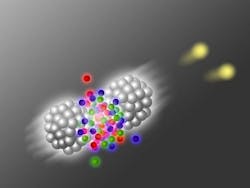CERN collider could produce world’s shortest yoctosecond-scale light pulses
Vienna, Austria--Scientists at the Vienna University of Technology (TU Vienna) have demonstrated, using computer simulations, a new method using heavy ion collision equipment at CERN (the European Organization for Nuclear Research in Geneva, Switzerland) to make light pulses a million times shorter than previously possible. The pulses are so short that they cannot even be measured by today's technological equipment. But a method has been proposed to create the world's most precise stopwatch for these ultrashort light pulses using a detector that is going to be installed at CERN in 2018.
Phenomena taking place on very short time scales are often investigated using ultrashort laser pulses. Today, pulse durations of the order of attoseconds (billionths of a billionths of a second, 10exp-18 seconds) can be created. But these records could soon be broken. "Atomic nuclei in particle colliders like the LHC [Large Hadron Collider] at CERN or at RHIC [Relativistic Heavy Ion Collider at Brookhaven National Laboratory in Upton, NY] can create light pulses which are still a million times shorter than that," says Andreas Ipp from TU Vienna.
In the ALICE (A Large Ion Collider Experiment) experiment at CERN, lead nuclei are collided almost at the speed of light. The debris of the scattered nuclei together with new particles created by the power of the impact form a quark-gluon plasma--a state of matter that is so hot that even protons and neutrons melt. The quark and gluon building blocks can move independently without being bound to each other and this quark-gluon plasma only exists for several yoctoseconds (10exp-24 seconds). Unfortunately, conventional measurement techniques are much too slow to resolve flashes on a yoctosecond timescale. "That's why we make use of the Hanbury Brown-Twiss effect, an idea which was originally developed for astronomical measurements," says Ipp.
In a Hanbury Brown-Twiss experiment, correlations between two different light detectors are studied. That way, the diameter of a star can be calculated very precisely. "Instead of studying spatial distances, the effect can just as well be used for measuring time intervals," says Peter Somkuti, PHd student at TU Vienna, who carried out many of the calculations. The computer simulations show that the yoctosecond pulses of the quark-gluon plasma could be resolved by a Hanbury Brown-Twiss experiment. "It would be hard to do, but it would definitely be achievable," says Ipp. This experiment would not require any additional expensive detectors; it could be done with the "forward calorimeter" that is supposed to go on line at CERN in 2018. That way, the ALICE-experiment could become the world's most accurate stopwatch.
Studying the light pulses from the quark-gluon plasma could yield valuable new information to better understand this state of matter. In the future, the light pulses could perhaps even be used for nuclear research. "Experiments using two light pulses are often used in quantum physics," adds Ipp. "The first pulse changes the state of the object under investigation, a second pulse is used shortly after that, to measure the change." With yoctosecond light pulses, this well-established approach could be used in areas that up until now have been completely inaccessible to this kind of research.
SOURCE: Vienna University of Technology; www.tuwien.ac.at/en/news/news_detail/article/7842/
IMAGE: Two lead atoms collide, creating a quark-gluon plasma that can emit ultrashort laser pulses. (Courtesy Vienna University of Technology)
